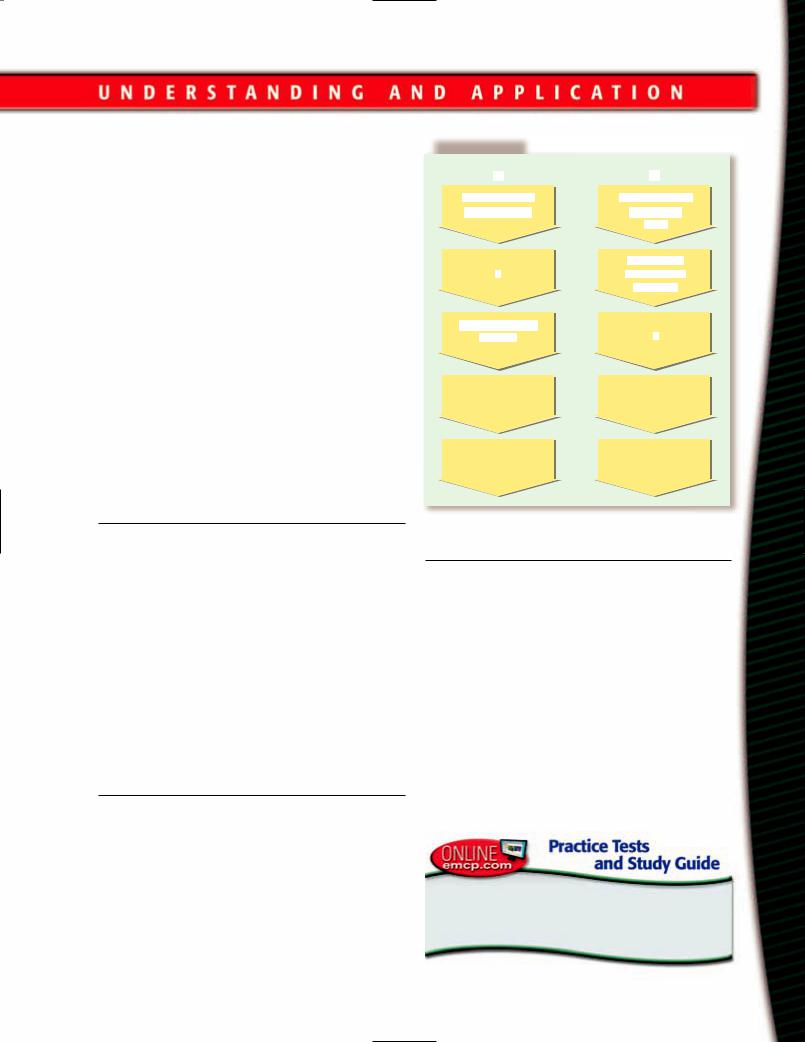
Economics_-_New_Ways_of_Thinking
.pdf
The Organization of Petroleum Exporting Countries (OPEC) is a cartel. Here OPEC president, Indonesian oil minister Purnomo Yusgiantoro, opens an OPEC meeting at its headquarters in Vienna. Why do you think cartels are illegal in the United States?
three automobile company CEOs. You return to your office after lunch with the other CEOs. You start to think about the cartel agreement you just entered into and say to yourself, “I know I promised not to
lower prices and not to develop any new model cars, but suppose I forget what I promised. Suppose I develop new car models and release them to the market next year. If my competitors hold to the cartel agreement, they will not release new models next year, and I will be the only car
company with new models. My company should be able to take business away from our competitors. Instead of not competing with my competitors, why don’t I just try to run them out of business?”
Each of the CEOs feels a strong monetary incentive to break the promise made with the other CEOs. Each is likely to break the agreement in the hope of getting rid of his or her competition, once and for all. If all three break the agreement out of self-inter- est, the agreement is gone. The three car companies are back where they started, competing with each other.
Even if cartel agreements were not illegal, they probably would not be much of a problem for consumers. Certainly sellers in the same market might try to make cartel agreements and would want them to hold, but it is not likely that they would hold. After all, once the agreement was made, each seller that entered into it would feel a sharp monetary incentive to break it and make itself much better off at the expense of its competitors. It’s nearly impossible for companies to turn their backs on the chance to get rid of their competition.
Is It Buyers Against Sellers or Sellers Against Sellers?
The noneconomist may think that the best interests of consumers or buyers are pitted against the best interests of producers or sellers. They may believe that buyers want to buy high-quality products at low prices. Sellers want to produce cheap products and sell them for high prices. Whatever is good for buyers is bad for sellers, and whatever is good for sellers is bad for buyers. In short, buyers and sellers are on different sides of the fence; it’s sellers against buyers.
Putting things this way makes it sound as if buyers and sellers are natural enemies and always at war. However, this view does not accurately represent the forces at work. The real war may not be between buyers and sellers but among sellers. Sellers may indeed be on one side of the fence and buyers on the other side, but not all the sellers on the same side of the fence are happy with one another. Some want to get rid of other sellers so that there will be fewer sellers on the selling side of the fence. General Motors wants to get rid of Toyota so there will be fewer car companies. Dell wants to get rid of HewlettPackard so there will be fewer computer manufacturers. NBC wants to get rid of CBS; and NBC, CBS, and ABC wish that cable television had never come to exist.
Sellers may (initially) have interests opposed to those of consumers, but it does not mean sellers will get what they want at the expense of consumers. Often, what keeps sellers in line is other sellers—either other sellers currently in the market or sellers who
214 Chapter 8 Competition and Markets

may one day enter the market. In other words, it is the threat of actual or potential competition from other sellers that ends up aligning the interests of sellers with buyers. It is competition between sellers that keeps downward pressure on prices (sellers want to underprice their competitors) and on costs (if sellers can lower their costs, then they have a better chance of outcompeting their competitors).
QUESTION: What about underhanded, manipulative sellers who try to scam buyers?
ANSWER: Probably all buyers have come across sellers that haven’t told them everything they would like to know about a product, or tried to get them to buy something they might not have wanted, or tried to cheat them in some way. Nothing we have said is meant to imply that unscrupulous sellers do not exist. What we are suggesting, though, is that what essentially keeps sellers in line, and trying to serve the buying public, is not a seller’s “big heart,” but the competition it faces from other sellers. In other words, fewer sellers and less competition would mean a lot more “underhanded, manipulative sellers” in the world.
Price Discrimination
Price discrimination exists when a seller charges different prices to different buyers, and the price differences do not reflect cost differences. Suppose a movie theater charges children $4 to see a movie and charges adults $8 to see a movie. If the movie theater experiences absolutely no cost difference when it comes to children and adults, this situation would be an example of price discrimination.
Now suppose a company runs two small grocery stores: one on the east side of town and one on the west side of town. In the grocery store on the east side of town it charges $3 for a loaf of bread, but on the west side of
town it charges $2.50 for the same loaf of bread. Is this situation an example of price discrimination? Well, it could be, but not necessarily. In this town, the crime rate is higher on the east side than on the west side, which means the insurance rates for the company are higher on the east side of town. As a result, it may be more costly to sell bread on the east side of town than on the west side of town, and this higher cost is reflected in the higher price of bread on the east side of town. The difference in price here is not an example of price discrimination.
When we have price discrimination, though, we need to ask two important questions: (1) Why would a seller want to price discriminate? (2) Under what conditions can a seller price discriminate?
Why Discriminate?
A seller would want to price discriminate if it increased total revenue. Look at the following three points on a market demand curve.
Point |
Price |
Quantity demanded |
A |
$10 |
1 |
B |
8 |
2 |
C |
6 |
3 |
As you can see, price and quantity demanded move in the opposite direction according to the law of demand, which says that more is purchased at lower prices than at higher prices.
price discrimination
Practice by which a seller charges different prices (to different buyers) for the product it sells when the price differences
do not reflect cost differences.
Would CNN’s coverage of news events, such as Barack Obama’s speech at the Democratic National Convention in 2004, improve or decline if Fox News and MSNBC went off the air?
Section 4 An Oligopolistic Market 215

Do You ?
Sometimes
Choose to
Pay Higher
Prices?
As you know, one of the conditions of price discrimina-
tion is that the seller be able to distinguish among customers who would be willing to pay different prices.
Ask yourself whether people who value their time highly are more willing to pay a higher price for a product than people who do not. Some sellers think so. They argue that people who place a high value on their time want to economize on the shopping time connected with the purchase of the product. If sellers want to price discriminate between these two types of customers—charging more to
customers who value time more and charging less to customers who value their time less—they must determine the category into which each of their customers falls.
How would you go about making this determination if you were a seller? What many sellers do is place cents-off coupons in newspapers and magazines. They think that people who value their time relatively low will spend it clipping and sorting coupons. People who place a relatively high value on their time will not.
In effect, the process works in a similar way at your local grocery store.
•The posted price for all products is the same for all customers.
•Both Linda and Josh put the cereal in their shopping carts.
•When Linda goes through the checkout, the clerk asks her if she has any coupons. Linda says
no, so Linda pays the posted price.
•When Josh goes through the checkout, he says he has a coupon for the cereal, and so he ends up paying a lower price than Linda paid.
Do you think that people in their thirties
are more or less likely to use coupons than people in their late sixties? Explain your answer.
Now suppose the seller can only charge one price and wants to sell 3 units of the good. What price will the seller charge? The answer is $6, because only at $6 will 3 units of the good be purchased. (If the seller charges $8, only 2 units will be purchased.) The total revenue for this seller is $18, which is the price of the good ($6) times the quantity bought (3).
Now suppose this seller can price discriminate, or charge one price to one buyer and a different price to another buyer. The seller will charge one buyer $10 (because from our table we know that at least one buyer is willing and able to pay $10 for the good—after all, we can see that the quantity
demanded is 1 at a price of $10), and then charge another buyer $8 (because we know that that the price of the good has to be $8 before another person will buy the good). The seller charges a third person $6 (because we know that the price of the good has to be $6 before a third person will buy the good). What is the seller’s total revenue now? It is the sum of $10 and $8 and $6, or $24.
In other words, if the seller does not (or cannot) price discriminate, and charges the same price to all customers, total revenue is $18. But if the seller can and does price discriminate, charging different prices to different customers, total revenue increases by $6 to a total of $24.
216 Chapter 8 Competition and Markets

It would seem, then, that every seller in the world would want to price discriminate. In fact, every seller does want to price discriminate—but not every seller can. Certain conditions must be present.
Factors Allowing Price Discrimination
First, different customers must be willing and able to pay different prices for a good. In other words, one person is willing and able to pay $10 for the good, but another person is only willing and able to pay $8 for the good.
Second, the seller requires a way to tell who is willing to pay $10 and who is only willing to pay $8. (By the way, buyers don’t willingly give up this information.)
Third, it has to be impossible, or extremely costly, for the good that is purchased by one customer to be resold to another. For example, suppose the person who bought the good at $6 (in the example earlier) could buy 3 units of the good at this price. Then this buyer could turn around and sell one unit of the good to another buyer for, say, $10, and one unit of the good to still another buyer for $8. Instead of the seller capturing the “$6 added revenue” from price discrimination, it goes instead to one buyer.
Where Does Price Discrimination
Occur?
Think of the places where you might see price discrimination. Often restaurants will sell a dinner to an older person for less than it will sell the same dinner to a younger person. In other words, the older person gets the “senior discount.” Here is an example where the good the older person buys is not usually resold. We have never seen an older person in a restaurant buy the salmon and vegetables for $15 and then try to sell it for $20 to the person at the next table.
As we mentioned earlier, we sometimes see price discrimination at a movie theater. Young kids are often charged less than adults. Again, little if any reselling is going on here. A kid doesn’t typically buy 100 tickets for $4 each and then stand outside the movie theater selling them for, say, $7 each.
You will also sometimes see price dis- |
Can you think |
crimination at a pharmacy. An older person |
of ways in which |
may perhaps pay a lower price for a medi- |
this major retailer, |
cine than a younger person. Here again |
which sells men’s |
reselling of the medicine is unlikely. Older |
and women’s |
people (and younger people too) only buy |
fashions at its |
medicine they seem to need. Did you ever |
Web site and in |
see an older person standing outside of the |
stores across the |
pharmacy offering a 40-year-old his or her |
country, might |
high blood pressure medicine for a lower |
practice price |
price than the 40-year-old has to pay? |
discrimination? |
Why Not Higher Prices for Everyone?
Here’s something to consider, though: |
|
why does the seller charge a lower price to |
|
some customers than to |
|
others. For example, if the |
|
older person would pay $20 |
“If you wish to prosper, let |
for the salmon and vegeta- |
your customer prosper.” |
bles, why charge $15? If the |
—Frederic Bastiat |
|
young kid would pay $8 to |
||
|
||
get into the movie, why |
|
|
charge $4? The answer is because the seller |
||
believes that older persons (on average) |
||
won’t pay $20 for the salmon and vegetables |
||
and that young kids (on average) won’t pay |
||
$8 to get into the movie. |
|
|
It’s not that the seller is trying to “do a |
||
favor” for the older person or the young |
||
Section 4 An Oligopolistic Market 217

??? |
|
CouldYourZIP |
|
Code |
CostYou? |
|
|
In 2000, Amazon.com, the large online seller of books and more,
was charging different prices for its new DVDs. Some customers were charged a higher price than other customers. In other words, it looked as if Amazon.com was price discriminating. Amazon.com said that it was not; it said that it was engaged in a random “price test,” to find out what customers were willing and able to pay for DVDs.
If you frequent an online seller regularly, as many people do who buy books from Amazon.com, it is possible for the online seller to acquire certain information about your buying habits. For example, it is not difficult for an online seller to know the dollar amount of your
purchases and the frequency of your purchases. For example, almost any online bookseller you deal with will know your buying history with it.
Also, because online sellers must send you (through the mail) the products you buy, they naturally know your ZIP code. Once an online seller knows your ZIP code, it is fairly easy to find the median family income earned in that ZIP code. At the Bureau of the Census Web site (www.emcp.net/census), you can key in the ZIP code and it will provide income information. For example, by keying in the ZIP code “90029,” we learned that the median family income is $87,416. By keying in the ZIP code “24108” we learned that the median family income is $66,678. An online seller could easily link your name to your ZIP code so that the next time you visit its site, you see the prices for that particular ZIP code. (Might people who live in Beverly Hills, California, be willing and able to pay
higher prices for books and DVDs than people who live in a small, rural town in the Midwest?)
As far as we know, no seller does what we have suggested here. However, it doesn’t mean that it might not become a topic of discussion in the months and years ahead.
THINK What is your opinion
ABOUT IT |
of price discriminating |
|
|
according to ZIP code? |
|
kid. It’s that the seller has some reason to believe that the older person will not buy the dinner unless it is priced at, say, $15. How does the seller know? It might be because at $20 a dinner, very few older persons show up to buy the meal, but at $15 a dinner, many do. The situation is similar with the movie theater and the young kids. It might be that if the price is $8 for adults and for kids, few young kids would show up at the movies. Parents might leave their kids at home, or with a babysitter, if they have to pay $8 for their young kids, but will bring their kids along to the movie if the price is $4 for the kids.
QUESTION: Does one buyer end up paying a higher price because some other buyer pays a lower price? For example, does some 30-year-old end up paying more for a dinner because some people get a “senior discount”?
ANSWER: No, but most people seem to think it works this way. The seller wants to charge both the 30-year-old and the older person the highest price each is willing and able to pay. If possible, the seller would charge the older person $20 for the dinner
218 Chapter 8 Competition and Markets

Do you think some people pay more for a medical procedure because others pay less? How might an economist answer this question?
instead of $15. If the seller did charge $20 to the older person, that seller wouldn’t then be content enough to charge the 30- year-old only $18 for the dinner. The seller would still charge the 30-year-old $20 for the dinner. Again, the objective is to charge everyone the highest price he or she is willing and able to pay, no matter what someone else pays.
Price Discrimination and the Law
The general perception is that price discrimination is illegal in the United States. It is
illegal under certain conditions. For example, it is illegal if a seller price discriminates, and, as a result, injures competition (which usually means reducing the amount or intensity of competition in the market). It is also usually illegal if one of the discriminating sales crosses state lines (for example, when a seller sells a good for less in one state than in another state and the difference in price is not warranted by a difference in costs). Price discrimination is not usually deemed illegal by government authorities if no injury occurs to competition or if the seller can show that charging a lower price to some customers is necessary to adequately compete in the market.
Defining Terms
1.Define:
a.oligopolistic market
b.cartel agreement
c.price discrimination
Reviewing Facts and
Concepts
2.Why might a firm that voluntarily entered into a cartel agreement decide to cheat on (or breach) the agreement?
3.Why are oligopolistic firms price searchers?
4.What conditions are necessary before a seller can practice price discrimination?
Critical Thinking
5.If perfectly competitive firms are price takers, and monopolistic, monopolistic competitive, and oligopolistic firms are price searchers, then it follows that three times as many firms in the real world are price searchers than are
price takers. Do you agree or disagree? Explain your answer.
Applying Economic
Concepts
6.Someone tells you that the firms in a particular industry are all selling their products for the same prices. Does it follow that the firms have entered into a cartel agreement?
Section 4 An Oligopolistic Market 219

Chapter Summary
Be sure you know and remember the following key points from the chapter sections.
Section 1
The four types of market structure are perfectly competitive, monopolistic, monopolistic competitive, and oligopolistic markets.
A perfectly competitive market has many buyers and sellers who have relevant information about prices, quality, and other factors; its firms sell identical goods; and market entry and exit are easy.
Section 2
A monopolistic market consists of one seller of a good that has no good substitute in a market with high barriers to entry.
A monopoly firm searches for the price at which it can maximize its profits.
Some barriers to entry into a monopolistic market are legal barriers.
Section 3
A monopolistic competitive market includes many buyers and sellers; firms produce and sell slightly differentiated products; and market exit and entry are easy.
Monopolistic competitive firms are price searchers because of the slight differentiation in their products.
Like other firms, monopolistic competitive firms must answer the questions of how much to produce and what price to charge.
Section 4
An oligopolistic market has few sellers, firms sell either identical or slightly differentiated goods, and market entry and exit are difficult.
Oligopolistic firms have some control over the price they charge.
The barriers to market entry limit the amount of potential competition for oligopolistic firms.
Economics Vocabulary
To reinforce your knowledge of the key terms in this chapter, fill in the following blanks on a separate piece of paper with the appropriate word or phrase.
1.A(n) ______ is a seller that can sell all its output at the equilibrium price but none at 1 penny higher.
2.The conditions that characterize ______
include one seller, no close substitutes for the good the seller sells, and high barriers to entry.
3.A(n) ______ can sell some of its output at various prices, although it sells less output at higher prices.
4.A(n) ______ is a monopoly that is legally protected from competition.
5.A company that ends up being the only seller of a good because of its low average total cost is called a(n) ______.
6.The conditions that characterize ______
include many buyers and sellers, firms that sell slightly differentiated products, and easy entry into and exit from the market.
7.The conditions that characterize ______
include few sellers, firms that produce and sell either identical or slightly differentiated products, and significant barriers to entry.
8.An agreement among firms that specifies that they will act in a coordinated way to reduce the competition between them is called a(n)
______ agreement.
9.A(n) ______ is a right granted to the firm by the government that permits the firm to provide a particular good or service and excludes all others from doing so.
Understanding the Main Ideas
Write answers to the following questions to review the main ideas in this chapter.
1.Firm A is a perfectly competitive firm. Why can’t it sell its product for 1 penny higher than the equilibrium price?
2.Why is a monopoly seller a price searcher?
3.In at least one sense, a perfectly competitive firm is like a monopoly firm. Each firm sells its
220 Chapter 8 Competition and Markets

product for the highest price possible. Do you agree or disagree? Explain your answer.
4.How can low average total costs (per-unit costs) act as a barrier to entry?
5.What keeps any profits the monopoly seller is earning from being competed away?
6.What is a tying contract, and which antitrust act deems it illegal?
7.Firms in a monopolistic competitive market produce slightly different products. In what ways might these products differ?
8.What are the two principal determinants of how much competition a seller in a market faces?
9.Why might a cartel agreement be more likely in an oligopolistic market than in a monopolistic competitive market?
10.Explain why a firm that entered into a cartel agreement would cheat on or break that agreement.
11.Can every seller price discriminate? Explain.
Doing the Math
Do the calculations necessary to solve the following problems.
1.A monopoly seller produces and sells 1,000 units of a good at a price of $49.99 per unit. Its total cost is $30,000. How much profit does it earn?
2.A firm can sell 1 unit of good X at $40, and it can sell one additional unit for every $1 reduction in price. Its marginal cost is constant at $34. How many units of the good should the firm produce?
Working with Graphs and Tables
1.Exhibit 8-4(a) partly describes what happens in a competitive market when firms earn high profits. Fill in the missing boxes A through C.
2.Exhibit 8-4(b) partly describes what happens in a competitive market when firms in a market earn losses. Based on your knowledge of what happens when firms earn high profits, fill in the missing boxes D and E.
E X H I B I T 8-4 |
|
|
|
|
|
|
|
|
|
|
|
|
|
|
|
|
|
|
|
|||||||||
|
|
|
|
|
|
|
|
|
|
|
|
|
|
|
|
|
|
|
|
|
|
|||||||
|
|
|
|
|
(a) |
|
|
|
|
|
|
|
|
(b) |
||||||||||||||
|
|
|
|
|
|
|
|
|
|
|
|
|
|
|
|
|
|
|
|
|
|
|
|
|
|
|
|
|
Firms in market A |
Firms in market A |
|||||||||||||||||||||||||||
|
|
|
|
|
|
|
|
|
|
|
|
|
|
|
|
|
|
|
|
|
|
|
|
|
|
|
||
|
|
|
earn high profits |
|||||||||||||||||||||||||
|
|
|
|
|
|
|
|
|
are incurring |
|||||||||||||||||||
|
|
|
|
|
|
|
|
|
|
|
|
|
|
|
|
|
|
|
|
|
|
|
|
|
|
|
|
|
|
|
|
|
|
|
|
|
|
|
|
|
|
|
|
|
|
losses |
|||||||||||
|
|
|
|
|
|
|
|
|
|
|
|
|
|
|
|
|
|
|
|
|
|
|
||||||
|
|
|
|
|
|
|
|
|
|
|
|
|
|
|
|
Some firms in |
||||||||||||
|
|
|
|
|
|
|
|
|
|
|
|
|
|
|
|
|
|
|||||||||||
|
|
|
|
|
|
A |
|
|
|
|
market A leave |
|||||||||||||||||
|
|
|
|
|
|
|
|
|
|
|
|
|
|
|
|
|
|
|
|
|
|
|||||||
|
|
|
|
|
|
|
|
|
|
|
|
|
|
|
|
|
|
the market |
||||||||||
|
|
|
|
|
|
|
|
|
|
|
|
|
|
|
|
|
|
|
|
|||||||||
Supply in market A |
|
|
|
|
|
|
|
|
|
|
|
|
|
|
|
|
||||||||||||
|
|
|
|
|
|
|
|
|
|
|
|
|
|
|
|
|||||||||||||
|
|
|
|
increases |
|
|
|
|
|
|
|
|
|
D |
||||||||||||||
|
|
|
|
|
|
|
|
|
|
|
|
|
|
|
|
|
||||||||||||
B |
Price rises |
C |
E |
Solving Economic Problems
Find solutions to the following problems.
1.Application. Lam goes to a car dealership to look at cars. The salesperson shows him the cars he wants to see and drive. The salesperson asks Lam what he does for a living. What is the economic reason for asking this question?
2.Analysis. Firm A has been producing and selling good A in market A for 10 years. Recently, other firms moved into market A and started to produce good A. Firm A asked the government to restrict the number of firms that can enter the market. Why would firm A want to restrict entry into the market?
Go to www.emcp.net/economics and choose Economics: New Ways of Thinking, Chapter 8, if you need more help in preparing for the chapter test.
Chapter 8 Competition and Markets 221

Why It Matters
Millions of people go to work every day. They work as cab drivers, computer programmers, attorneys, sales-
persons, construction workers, and accountants, among other things. Just as the work these people do differs from job to job, so does the pay, which is determined by supply and demand.
All of the workers mentioned above are part of the civilian labor force. The civilian labor force consists of men and women 16 years old or older who are either working at jobs or actively searching for jobs. One day soon you will be part of the civilian labor force, if you are not already. When that day arrives, you will probably think a lot about what you are paid in the labor market. This chapter will help you understand the labor market and why people get paid what they do.
222

The following events occurred one day in September.
7:14 A.M. Blake is up and watching television. He hears a story about professional basketball players and the high salaries they earn. Blake, an avid basketball fan, wonders why
some people end up making so much money.
• Is Blake part of the reason that professional basketball players earn high incomes?
8:44 A.M. Emily and her best friend, Karen, are having a cup of coffee at work. They talk about a TV documentary they saw last night about new immigrants to the United States. Emily says, “I thought the documentary made some good points—points I was unaware of.” “I know,” said
Karen. “I didn’t know that new immigrants could end up causing our wages to go down.” “But I don’t think that is what the documentary said,” says Emily. “I thought it said that new immigrants could, but need not lower
peoples’ wages, and not necessarily everyone’s wages—just some people’s wages.”
• What effect does immigration have on wages?
10:56 A.M. Jill works as an accountant in Atlanta. Her annual salary is $82,000. She just got off the phone with an accounting firm in Milwaukee. The vice president of the accounting firm in Milwaukee offered her a salary of $100,000 if she would come and work for the firm. The Milwaukee
firm has a reputation for disgruntled employees. Jill is thinking of turning down the offer.
• Would Jill be wrong to turn down the job in Milwaukee?
5:03 P.M. Stephen is 16 years old and works at a grocery store every day after school. He bags groceries and stocks food. He earns the minimum wage. Right now he is cleaning up in the back room of the store. A coworker of his just came into the back room. Stephen looks over and asks his coworker how much he is getting paid. The coworker says, “Same as you, the minimum wage.” “I wish I made a little more at this job,” Stephen says. “So do I,” says the coworker.
• Would Stephen have a job at the grocery store if the minimum wage were raised to $3 higher than it currently is?
223
